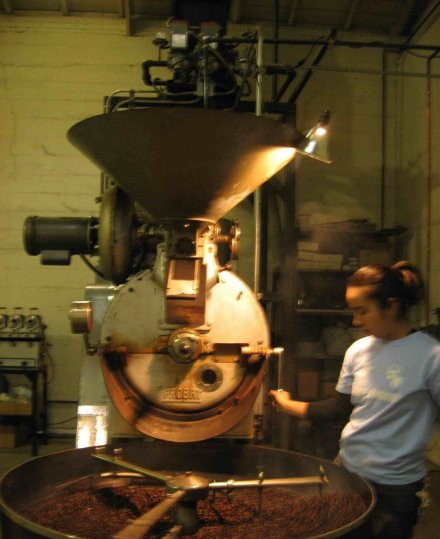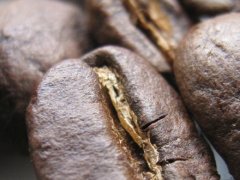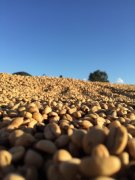Roasting technology is the coffee flavor formed naturally or baked?

"it tastes like pastry, sweet apricot pie."
"it smells like ripe currants."
Or "the taste of green peaches with cream."
In the process of drinking coffee, you sometimes hear these exotic taste adjectives. Then we can't help but wonder which flavors are inherent in coffee and which are created during roasting.
What we often encounter in raw coffee beans are the "farm flavor", such as the smell of grass and haystack. If there is something wrong with the transportation and storage of raw beans, it may produce mildew, dirty soil or even "cat smell"; in other cases, the fermented smell of raw beans smells like a bottle stopper of red wine for a few days.
With luck, when you open a sack of raw coffee beans, there will be a sweet smell of ripe fruit. I'm even sure that the fragrance you smell is colored. Yes, red. If you think it's unreliable,
Try a sensory experiment with a bag of lollipops. I'm sure most of the smells will generate clear colors in your brain without looking at them.
Most of the coffee flavors described above are produced during the initial processing, storage, packaging and transportation of raw coffee beans. A large part of the flavor of these raw beans will not be lost by the baking process. Only when the degree of baking is very deep, these flavors will be masked.
Other flavors and aromas come more from the contents of the coffee beans themselves. The main determining factors are: (assuming that coffee cherries are picked after maturity) the growth latitude of the coffee tree, the variety of coffee beans, soil conditions and other climate variables.
When a coffee roaster designs a blend, each kind of coffee bean becomes a raw material, just as the chef chooses on a rich variety of spice shelves; the baker needs to know clearly the taste of each bean into the cup, and the main role of some beans in this blending is not the wind.
The taste is not the aroma, but the mellow thickness and taste she brings. In short, in a matching formula, each bean has its own specific role.
In this way, what flavors are there that bakers can polish and create?
Professional bakers will divide all the flavors into an 8-point roulette. Of course, there will be a lot of excessive taste in between, but the most basic taste can be summarized as shown in the table above.
The taste on the left side of the roulette is closer to the taste of the coffee bean itself; when it is underbaked or baked too fast, the beans will taste like haystacks and wheat. On the right side of the roulette, we will taste the sour taste like lemon.
During the baking process, the acid turns into softer malic acid, which in turn develops into a wine-like taste, bright and refreshing.
In the other half of the flavor wheel, it is the favorite taste of most people; here, the sweetness of baking outweighs the sour taste, and with the deepening of the degree of baking, it is transformed into different degrees of caramel flavor and then to the flavor of cocoa. Its alcohol thickness also reached the highest level at this critical point. If you continue to bake
In other words, the sweetness fades away and the bitterness emerges, which tastes a bit like 80% pure dark chocolate. If you bake for too long, the delicious taste in the beans will almost disappear and be replaced by the smell of barbecue and coke.
In general, bakers can't make "apples and mayonnaise", but they can create a blend of coffee beans in minutes to make them taste very thick and baked sweet (like mayonnaise). It also has a sour aftertaste (like green apples).
Let's continue to use the cook analogy. We know that the heat of cooking will also affect the taste of this dish, because each raw material will release different fragrance at different temperatures. For example, onions. In the process of stir-frying, it will change from simple spicy and astringent taste to sweetness, caramel, baked aroma and charred taste.
It all depends on the size of the heat and the time of stir-frying. We can think of this process as the baking quality of onions.
Therefore, when you are looking for or designing a coffee blend, as long as you provide enough feedback, the baker will be able to design your own recipe with different proportions of coffee beans. Remember, just tell them which flavors you want and their position in the flavor wheel.
Important Notice :
前街咖啡 FrontStreet Coffee has moved to new addredd:
FrontStreet Coffee Address: 315,Donghua East Road,GuangZhou
Tel:020 38364473
- Prev

Roasting technology of boutique coffee beans benefits of wood roasting coffee
All coffee roasting machines work on the same principle: heat raw coffee beans, produce physical and chemical changes and turn them into roasted beans. Physical change means that the color of raw coffee beans changes from green to brown, and the shape changes accordingly. Chemical changes are much more complex, which is the process of production, balance and transformation of substances with fragrance, acidity and other odor components.
- Next

Roasting Technology of Fine Coffee beans Coffee Baking training and Teaching Summary
The principle and process of coffee roasting we must first understand that raw beans are hard seeds in coffee berries, such as water, chlorogenic acid, protein, alkaloids, caffeine, fats, sugars and so on. While baking at high temperature, the above substances will undergo chemical changes such as Mena reaction and Stryker degradation, resulting in coffee tannic acid, nicotinic acid, aromatic esters, alcohols,
Related
- What is the meaning of lactic acid fermentation with coffee bean treatment?
- How to judge the state of foam by sound?
- How does the latte pull out the unicorn pattern? Come to get for a little trick to improve the flower pull!
- Will flower pulling affect the taste of the latte?
- Do you know the history of coffee?
- The difference between honey treatment and sun washing what is raisin honey treatment?
- What kind of milk can a novice use to make coffee foam to keep the foam longer? The correct method and skills of milking tutorial sharing
- Why do washed coffee beans taste sour? Flavor characteristics of washed Coffee
- Introduction to the skill of how to practice the size and height of water injection around the circle of hand-brewed coffee
- How do beginners practice coffee flower drawing from scratch?

